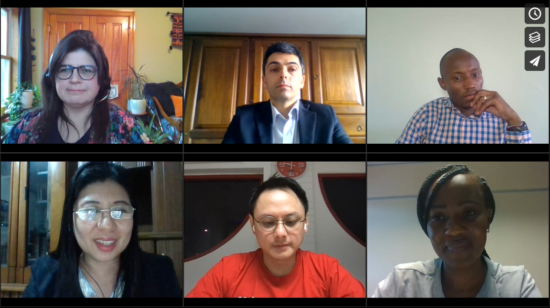
02 Mar No Return to Normal: Ensuring an Optimized Health Workforce in the Post COVID-19 Recovery

Erin Seiler is a senior program manager in Chemonics Global Health Division, supporting the HRH2030 program.
As we enter the Year of the Health and Care Workers, we are in a timely position to pause and reflect on adaptations to the service delivery landscape in response to COVID-19 and how these adaptations and innovations impact human resources for health needs and requirements moving forward, allowing us to “define a new normal for HRH.”
With these words, Diana Frymus, health workforce branch chief of the USAID Bureau of Global Health, Office of HIV/AIDS, opened HRH2030’s recent webinar, “No Return to Normal: Ensuring an Optimized Health Workforce in the Post COVID-19 Recovery.” Featuring presentations and a discussion among five panelists with diverse perspectives, the event highlighted innovations, lessons learned, and solutions that countries and organizations are acting upon to create a ‘new normal’ for the health workforce for 2021 and beyond.
Among the four key actions they recommend:
Modifying and optimizing service delivery models
In Lesotho, the government shifted 10% from each ministry’s budget towards the national response to COVID-19. This financial strain, coupled with the COVID crisis, necessitated engaging the health workforce differently to maintain essential services such as those for HIV/AIDS. A team approach was instituted to share tasks among health professions –specialists and nurses were re-deployed to ICUs, and trained to do more complex care, joining with other clinicians to provide essential health services.
In addition, Lesotho is working to further introduce various patient-centered approaches that are also proving beneficial to easing health workforce constraints. Health workers are now conducting more home visits, to reduce their risks and clients’ risks of contracting the virus from patients in health facilities and to decongest facilities. E-pharmacy lockers (an electronic locker system) are being piloted to provide multi-month prescriptions and dispensing of ART and other medications for chronic illnesses, streamlining these processes to help further reduce health worker workload.
Expanding engagement with the private health sector
The COVID-19 pandemic has exacerbated the burden on public health systems, highlighting more than ever before the need to leverage the private sector workforce.
Across Africa, where private sector responses are accelerating, engaging early and often is one key to success. Panelist Mbogo Bunyi, senior private sector advisor to USAID-funded SHOPS Plus, cited Senegal, where after years of building trust across the public health sector and private health actors, the health ministry regularly brings the two together when planning for public sector responses. The country’s Private Sector Alliance provides a forum for data sharing so that all actors are more fully informed and able to contribute to a comprehensive health response. When the pandemic reached Senegal, they were able to quickly establish regional COVID-19 task forces mapping out the locations of private sector outlets and providers that could be mobilized for the response. This mobilization resulted in over 1,000 private health providers and district and regional -level paramedical workers trained on COVID-19 identification, testing, response, infection prevention and control for COVD-19. In Rwanda, SHOPS Plus helped successfully advocate for a new task-sharing policy to allow for provision of injectable contraceptives at private pharmacies to expand access to family planning services. In Tanzania, successful advocacy with the government has allowed for the sale of HIV self-test kits in private pharmacies and drug shops, thus expanding access to essential HIV commodities. Other examples of opportunities to engage the private health sector include contracting with private providers to provide services. In Botswana, SHOPS Plus identified opportunities for the Ministry of Health to contract with private providers to strengthen the HIV response for uninterrupted service delivery and decongesting the public facilities. This includes contracting with the private pharmacies for ARV distribution, private doctors managing care and treatment for stable PLHIV and private labs contracted for viral load testing.
In Indonesia, private company Halodoc is also changing the way care is delivered. A 24/7 online healthcare platform created to address the complexities of delivering care across more than 17,000 Indonesian islands, Halodoc connects public and private health workers to patients through online clinical consultations, in person appointments, and access to hospitals, labs, pharmacies, and insurance providers. According to Dionisius Nathaniel, Halodoc’s chief marketing officer, the rise of “hospitals without walls” in Indonesia came about last year when the Indonesian Ministry of Health issued a new policy authorizing doctors to provide online consultation and prescription to patients, as a step in preventing the spread of COVID-19, by using information and communication technology to accelerate telemedicine services. This policy shift has allowed Halodoc to expand their engagement with health workers to reach more users, reaching 20 million monthly active users during the peak of the pandemic.
Using technology and data to support human resources for health
All panelists noted the important role of technology in this ‘new normal’ to support health care workers and the continued provision of healthcare services to clients.
Dr. Pretchell Tolentino, director of the Health Human Resources Development Bureau in the Philippines, shared how health workers’ use of the country’s Department of Health (DOH) Academy has skyrocketed since lockdowns began due to the COVID pandemic. This online training platform, developed with the support of HRH2030, was launched in November 2019 to reduce training costs and eliminate health workers’ absences from their posts when attending in-person trainings. With the onset of COVD-19, the DOH developed a COVID-19 Response Package of 10 courses, in addition to their slate of continuing professional development trainings, which has been taken by thousands of health workers, ensuring their provision of care is meeting national standards.
The WHO is taking this idea of online training for health workers and scaling it up to a global level, with the launch of the WHO Academy in May 2021, which will provide the latest health innovations and evidence-based guidance in online trainings. WHO surveyed tens of thousands of health workers and the data showed that HCWs felt a need to develop stronger skills and competencies for COVID-19, as well as a clear preference to have this training delivered via virtual platform and mobile app.
In Indonesia, Halodoc is continuously using data to tailor their services, Mr. Nathaniel said. Analyzing publicly available data along with their own internal data, Halodoc can quickly pivot to meet client needs. In response to data showing increased queries on mental health concerns during the pandemic, Halodoc engaged hundreds of additional psychologists, and is launching an AI chatbot as an initial assessment to cater to the rising demands for mental health and counseling services. Access to data, private partnerships, and a supportive government environment has also allowed them to expand their online platform to offline activities. In response to users’ inquiries about COVID-19 testing, Halodoc partnered with other private enterprises to offer thousands of free rapid COVID tests at drive-thru sites around Indonesia, and teamed up with health facilities to establish COVID-19 test drive thru sites which currently available across nine cities in Indonesia to expand access to testing services.
Advancing health workforce as part of broader governance and health financing reforms
From the perspective of Dr. Giorgio Cometto, unit head of the Department of Human Resources for Health at the WHO, “good governance capacity” is the key factor in the ability of health workers to respond effectively to this “new normal” during the pandemic and beyond. When countries are able to back up national policy decisions related to the health workforce with financial and logistical investments, they can more quickly adapt and respond to any crisis while continuing to deliver critical health services.
Dr. Cometto noted that one year into COVID, with the recognition of the health workforce as central to the vaccine roll-out, a primary lesson learned is that governments must invest in decent working conditions for health workers to feel protected and supported. A rapid review of the contributing factors to the “explosion of health worker strikes” since the COVID19 outbreak, showed that the primary reasons were difficult working conditions, a lack of personal protective equipment (PPE), and insufficient pay. To address many of these issues, WHO has rolled out select guidance including key considerations for occupational safety and health for health workers, and health workforce policy and management to support the pandemic response and maintain essential services.
New governance and health financing policies and partnerships are also needed to allow private health workers to reach the broader public health clientele, Mr. Bunyi of SHOPS Plus said. Advocacy to expand the role of the private sector in service delivery is necessary and can contribute to a more flexible health workforce, he noted, citing two examples. In Rwanda, a governmental policy change now allows pharmacists to administer injectable contraceptives, and in India, a private sector “e-pharmacy” platform brings TB testing and medication to patients’ doorsteps – both examples helping to relieve health workers burden through task-sharing and reducing congestion at clinics. However, payment for these private services require supportive government policies and processes for contracting out this work and/or involving insurance payment programs.
As Dr. Llang Maama-Maime, manager of Lesotho’s National TB and Leprosy Program, noted in a comment at the webinar’s conclusion, “We do not expect to go back to where we were and therefore, we shall have to maximize the resources available, including the human resources. Meaningful engagement of the private sector should be explored; investing in virtual learning is the future; and so is client-centeredness and community engagement to decongest our facilities and enhance good infection prevention and control while providing quality health care.”
Watch the event to see the complete discussion on optimizing the health workforce in the post- COVID-19 Recovery.
Photo: Top row from left to right: Wanda Jaskiewicz of HRH2030, Dr. Giorgio Cometto of WHO, Mbogo Bunyi of SHOPS Plus. Bottom row from left to right: Dr. Pretchell Tolentino of the Phillipines Department of Health, Dionisius Nathaniel of Halodoc, Palesa Pitso of Open Development.





